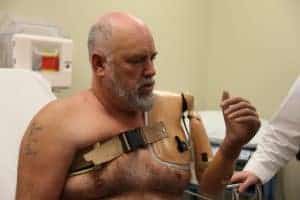The first memory David Scott has following his traffic accident July 31, 2017, is a paramedic leaning over trying to help release him from underneath his 18-wheeler.
“I’m trying to pull my arm out and they’re telling me I can’t,” Scott said. “So I turn around and try and force it. But they stopped me.”
That’s because at that moment, Scott wasn’t fully aware how badly his arm had been damaged. When he arrived at UAMS, his surgeons were not able to save it. And not just the arm, they and had to amputate up to his chest.
“Typically if an extremity is reconstructable, we will reconstruct it,” said Mark Tait, M.D., an orthopaedic hand and upper extremity surgeon and assistant professor in the Department of Orthopaedic Surgery. “In this case, his nerves, arteries and vessels were so severely damaged we had to do an amputation.”

But Tait and John Bracey, M.D., another UAMS orthopaedic hand and upper extremity surgeon, were thinking beyond the loss of Scott’s arm. They had plans for his future.
Traditionally, Tait said, patients can receive body-powered prosthetics. But new technology allows advanced robotics to be used by amputees. Because the surgeons decided to prepare Scott to be able to use a robotic arm, the surgery took about seven hours.
Tait and Bracey identified the nerves that once flowed in his hand, wrist and elbow. They then took those nerves and plugged them into other muscles in Scott’s chest. With time, the nerve would reinnervate – supply energy to – that muscle, causing it to have a new function. So now when Scott thinks, “close hand” or “bend elbow” new muscles, operated by nerves formally in his arm, respond. That response is sensed by his robotic arm, which follows the brain’s command.
“David is very highly motivated,” Bracey said. “He understood the severity of his injury but was determined not to be limited by that. His motivation helps make this so successful.”
UAMS is one of a few institutions in the nation able to do these kinds of surgeries and Scott is among the first here in the state to receive a robotic arm. Tait and Bracey say they’re happy to bring this option to amputees in Arkansas and the region. This procedure is also remarkable, the surgeons said, because it is intuitive. With more time and practice, a patient is able to fine-tune the way the robotic arm works with his or her body. He says they’re still working on improving the functionality.
“I told my wife, I’m not going to let this get me down,” Scott said.
And he hasn’t. His doctors expected it to take six months for him to make the progress he has made since having the arm. It’s taken him only three and each day he gets a little more control. He’s able to put the arm on and take it off with little to no help and has been very active in his church and his softball team.
“It’s amazing the things doctors have been able to come up with in medicine,” Scott said. “I’m happy to be alive and plan to make the most of my life.”
Tait and Bracey say even those who have already had an amputation could be eligible for robotic technology. Because the nerves are likely still there, they would still be able to identify them and plug them into different targets.
“It can be a good option for those even 10 years past their amputation,” Bracey said.

